Comprehensive Analysis: Samsung Electronics Business Strategy Report
VerifiedAdded on 2020/06/06
|9
|2722
|29
Report
AI Summary
This report provides a detailed analysis of Samsung Electronics' business strategy. It begins with an introduction to strategic concepts, followed by an examination of Samsung's business strategy, including its use of organizational and contingency theories, and strategies at different business levels. The report then conducts an organizational audit, utilizing SWOT analysis and Porter's Five Forces to assess internal and external factors. Finally, it explains Porter's Generic Strategies, such as cost leadership, differentiation, and focus strategies, as applied to Samsung. The report concludes with a summary of key findings and references supporting the analysis.
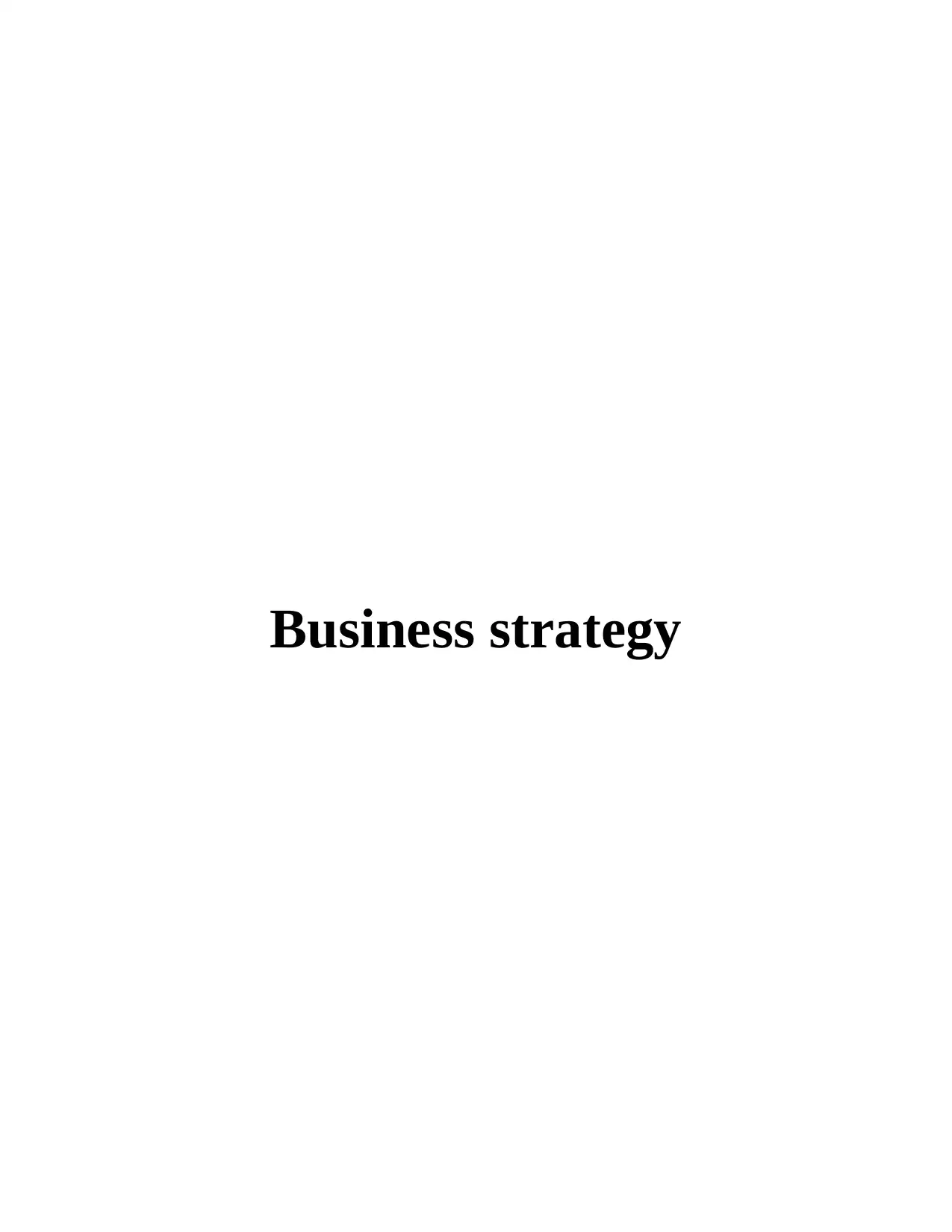
Business strategy
Paraphrase This Document
Need a fresh take? Get an instant paraphrase of this document with our AI Paraphraser
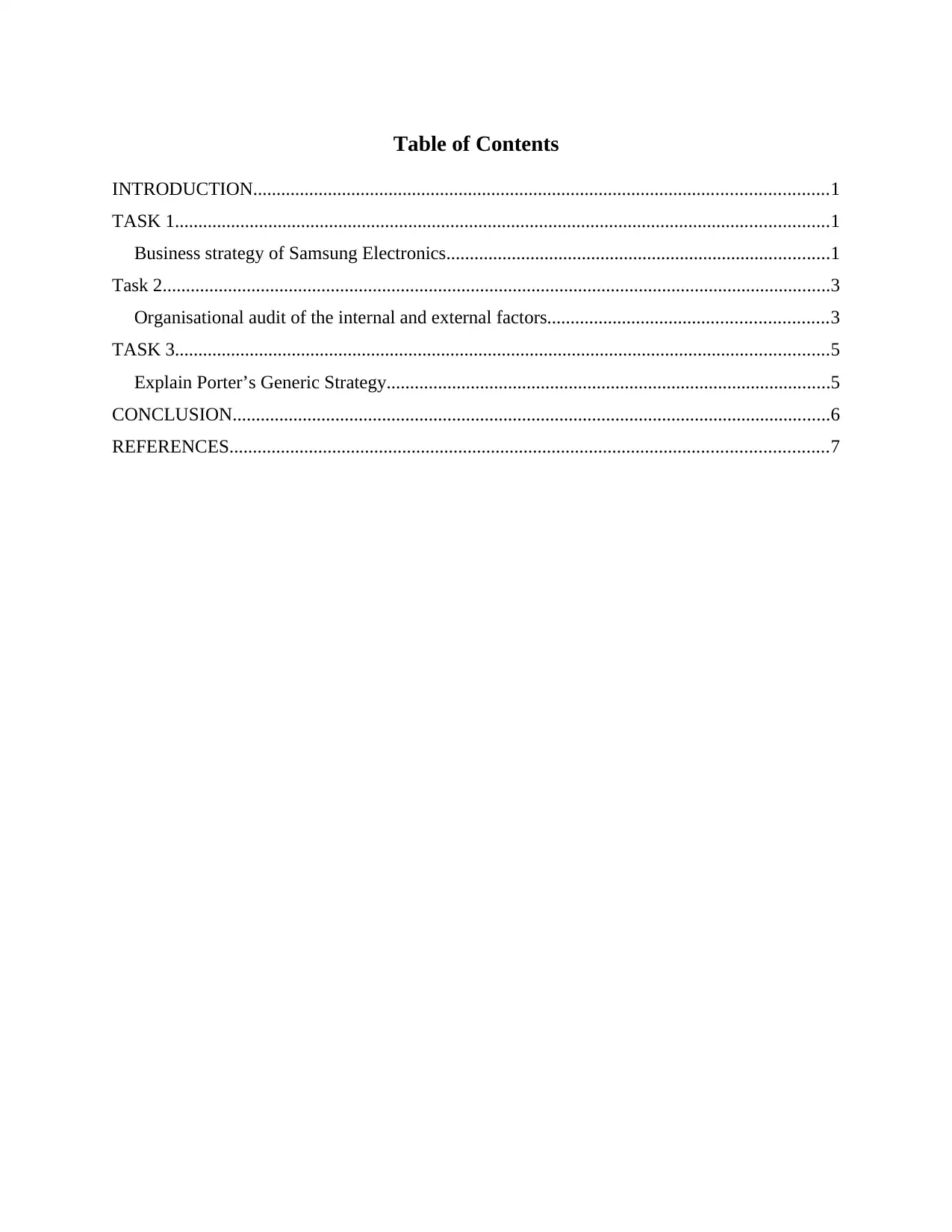
Table of Contents
INTRODUCTION...........................................................................................................................1
TASK 1............................................................................................................................................1
Business strategy of Samsung Electronics..................................................................................1
Task 2...............................................................................................................................................3
Organisational audit of the internal and external factors............................................................3
TASK 3............................................................................................................................................5
Explain Porter’s Generic Strategy...............................................................................................5
CONCLUSION................................................................................................................................6
REFERENCES................................................................................................................................7
INTRODUCTION...........................................................................................................................1
TASK 1............................................................................................................................................1
Business strategy of Samsung Electronics..................................................................................1
Task 2...............................................................................................................................................3
Organisational audit of the internal and external factors............................................................3
TASK 3............................................................................................................................................5
Explain Porter’s Generic Strategy...............................................................................................5
CONCLUSION................................................................................................................................6
REFERENCES................................................................................................................................7
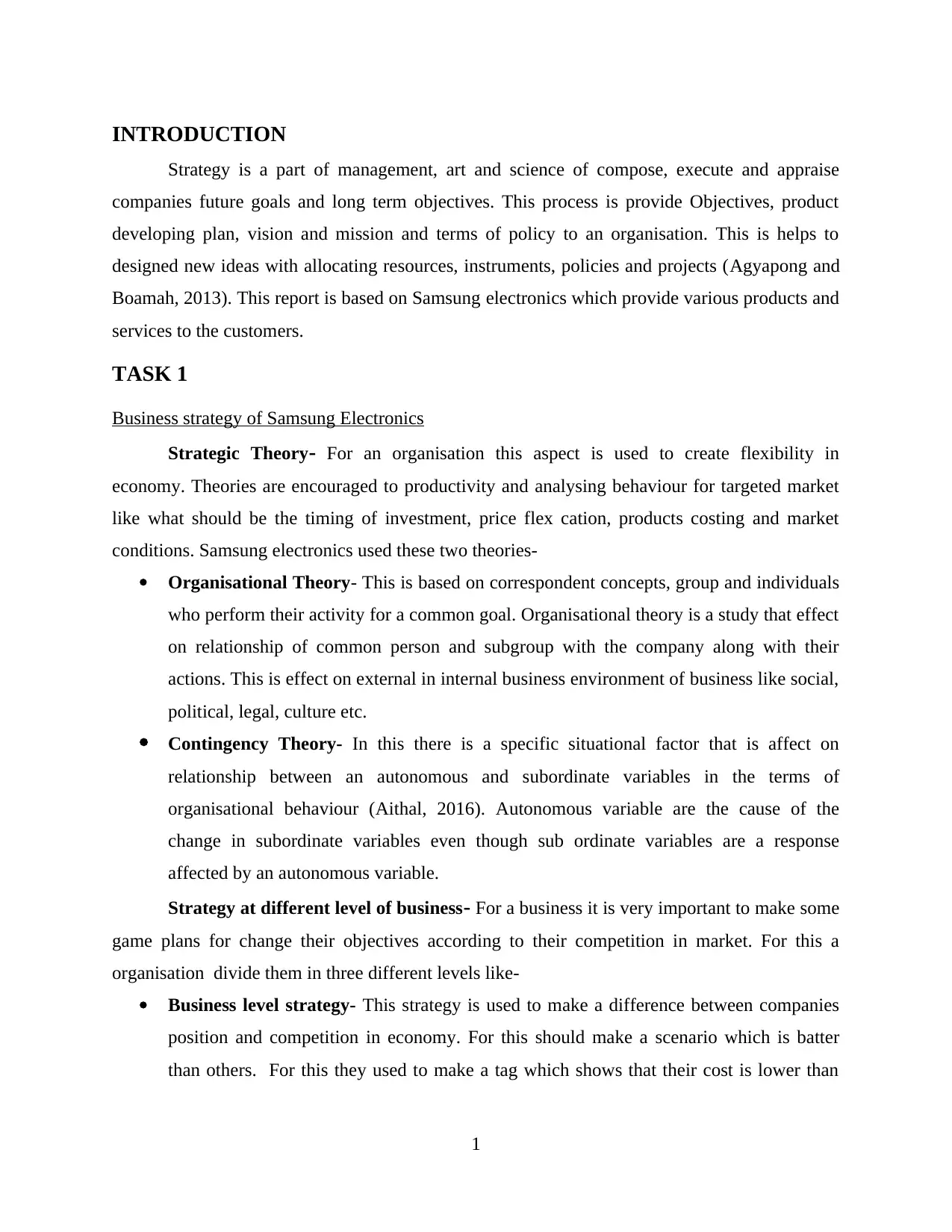
INTRODUCTION
Strategy is a part of management, art and science of compose, execute and appraise
companies future goals and long term objectives. This process is provide Objectives, product
developing plan, vision and mission and terms of policy to an organisation. This is helps to
designed new ideas with allocating resources, instruments, policies and projects (Agyapong and
Boamah, 2013). This report is based on Samsung electronics which provide various products and
services to the customers.
TASK 1
Business strategy of Samsung Electronics
Strategic Theory- For an organisation this aspect is used to create flexibility in
economy. Theories are encouraged to productivity and analysing behaviour for targeted market
like what should be the timing of investment, price flex cation, products costing and market
conditions. Samsung electronics used these two theories-
Organisational Theory- This is based on correspondent concepts, group and individuals
who perform their activity for a common goal. Organisational theory is a study that effect
on relationship of common person and subgroup with the company along with their
actions. This is effect on external in internal business environment of business like social,
political, legal, culture etc.
Contingency Theory- In this there is a specific situational factor that is affect on
relationship between an autonomous and subordinate variables in the terms of
organisational behaviour (Aithal, 2016). Autonomous variable are the cause of the
change in subordinate variables even though sub ordinate variables are a response
affected by an autonomous variable.
Strategy at different level of business- For a business it is very important to make some
game plans for change their objectives according to their competition in market. For this a
organisation divide them in three different levels like-
Business level strategy- This strategy is used to make a difference between companies
position and competition in economy. For this should make a scenario which is batter
than others. For this they used to make a tag which shows that their cost is lower than
1
Strategy is a part of management, art and science of compose, execute and appraise
companies future goals and long term objectives. This process is provide Objectives, product
developing plan, vision and mission and terms of policy to an organisation. This is helps to
designed new ideas with allocating resources, instruments, policies and projects (Agyapong and
Boamah, 2013). This report is based on Samsung electronics which provide various products and
services to the customers.
TASK 1
Business strategy of Samsung Electronics
Strategic Theory- For an organisation this aspect is used to create flexibility in
economy. Theories are encouraged to productivity and analysing behaviour for targeted market
like what should be the timing of investment, price flex cation, products costing and market
conditions. Samsung electronics used these two theories-
Organisational Theory- This is based on correspondent concepts, group and individuals
who perform their activity for a common goal. Organisational theory is a study that effect
on relationship of common person and subgroup with the company along with their
actions. This is effect on external in internal business environment of business like social,
political, legal, culture etc.
Contingency Theory- In this there is a specific situational factor that is affect on
relationship between an autonomous and subordinate variables in the terms of
organisational behaviour (Aithal, 2016). Autonomous variable are the cause of the
change in subordinate variables even though sub ordinate variables are a response
affected by an autonomous variable.
Strategy at different level of business- For a business it is very important to make some
game plans for change their objectives according to their competition in market. For this a
organisation divide them in three different levels like-
Business level strategy- This strategy is used to make a difference between companies
position and competition in economy. For this should make a scenario which is batter
than others. For this they used to make a tag which shows that their cost is lower than
1
⊘ This is a preview!⊘
Do you want full access?
Subscribe today to unlock all pages.

Trusted by 1+ million students worldwide
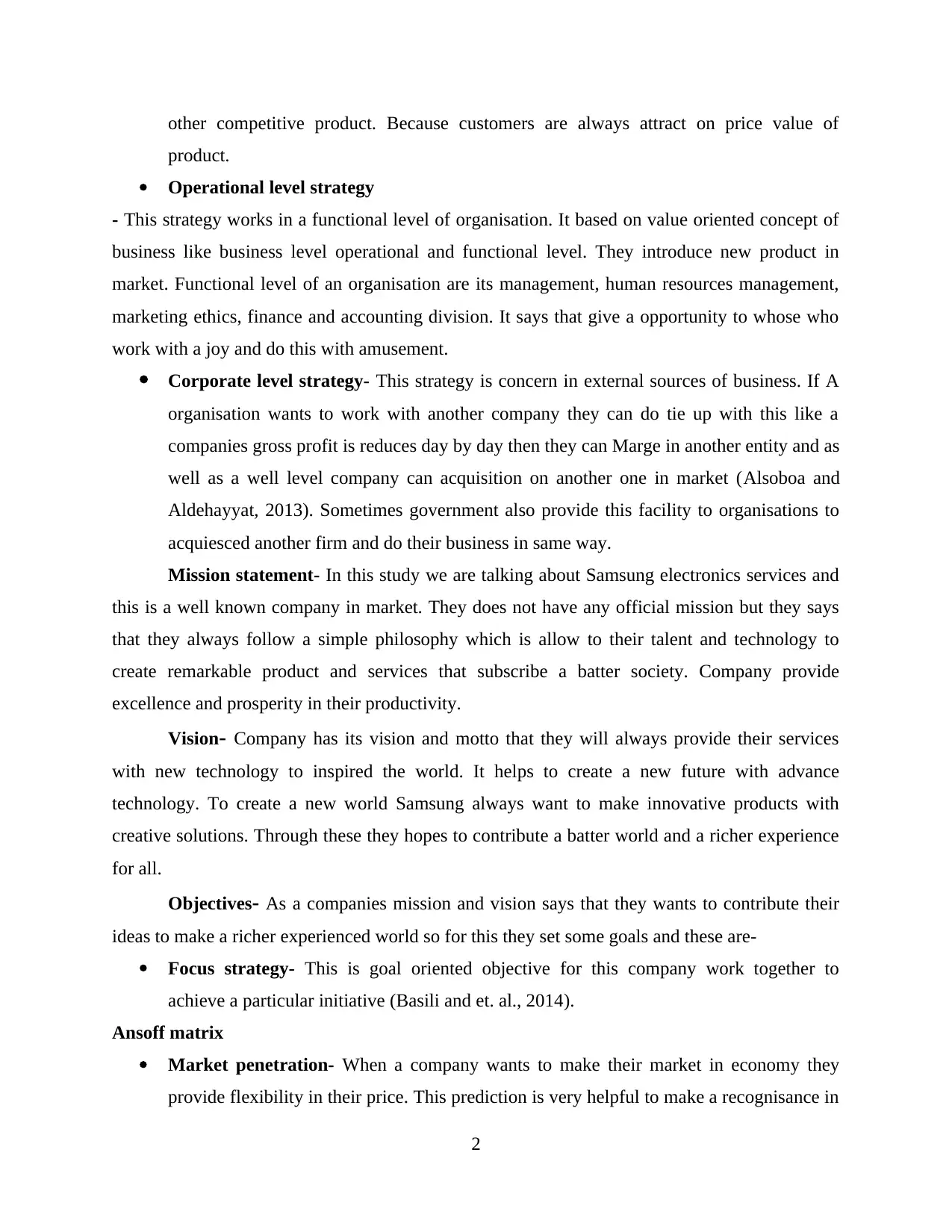
other competitive product. Because customers are always attract on price value of
product.
Operational level strategy
- This strategy works in a functional level of organisation. It based on value oriented concept of
business like business level operational and functional level. They introduce new product in
market. Functional level of an organisation are its management, human resources management,
marketing ethics, finance and accounting division. It says that give a opportunity to whose who
work with a joy and do this with amusement.
Corporate level strategy- This strategy is concern in external sources of business. If A
organisation wants to work with another company they can do tie up with this like a
companies gross profit is reduces day by day then they can Marge in another entity and as
well as a well level company can acquisition on another one in market (Alsoboa and
Aldehayyat, 2013). Sometimes government also provide this facility to organisations to
acquiesced another firm and do their business in same way.
Mission statement- In this study we are talking about Samsung electronics services and
this is a well known company in market. They does not have any official mission but they says
that they always follow a simple philosophy which is allow to their talent and technology to
create remarkable product and services that subscribe a batter society. Company provide
excellence and prosperity in their productivity.
Vision- Company has its vision and motto that they will always provide their services
with new technology to inspired the world. It helps to create a new future with advance
technology. To create a new world Samsung always want to make innovative products with
creative solutions. Through these they hopes to contribute a batter world and a richer experience
for all.
Objectives- As a companies mission and vision says that they wants to contribute their
ideas to make a richer experienced world so for this they set some goals and these are-
Focus strategy- This is goal oriented objective for this company work together to
achieve a particular initiative (Basili and et. al., 2014).
Ansoff matrix
Market penetration- When a company wants to make their market in economy they
provide flexibility in their price. This prediction is very helpful to make a recognisance in
2
product.
Operational level strategy
- This strategy works in a functional level of organisation. It based on value oriented concept of
business like business level operational and functional level. They introduce new product in
market. Functional level of an organisation are its management, human resources management,
marketing ethics, finance and accounting division. It says that give a opportunity to whose who
work with a joy and do this with amusement.
Corporate level strategy- This strategy is concern in external sources of business. If A
organisation wants to work with another company they can do tie up with this like a
companies gross profit is reduces day by day then they can Marge in another entity and as
well as a well level company can acquisition on another one in market (Alsoboa and
Aldehayyat, 2013). Sometimes government also provide this facility to organisations to
acquiesced another firm and do their business in same way.
Mission statement- In this study we are talking about Samsung electronics services and
this is a well known company in market. They does not have any official mission but they says
that they always follow a simple philosophy which is allow to their talent and technology to
create remarkable product and services that subscribe a batter society. Company provide
excellence and prosperity in their productivity.
Vision- Company has its vision and motto that they will always provide their services
with new technology to inspired the world. It helps to create a new future with advance
technology. To create a new world Samsung always want to make innovative products with
creative solutions. Through these they hopes to contribute a batter world and a richer experience
for all.
Objectives- As a companies mission and vision says that they wants to contribute their
ideas to make a richer experienced world so for this they set some goals and these are-
Focus strategy- This is goal oriented objective for this company work together to
achieve a particular initiative (Basili and et. al., 2014).
Ansoff matrix
Market penetration- When a company wants to make their market in economy they
provide flexibility in their price. This prediction is very helpful to make a recognisance in
2
Paraphrase This Document
Need a fresh take? Get an instant paraphrase of this document with our AI Paraphraser
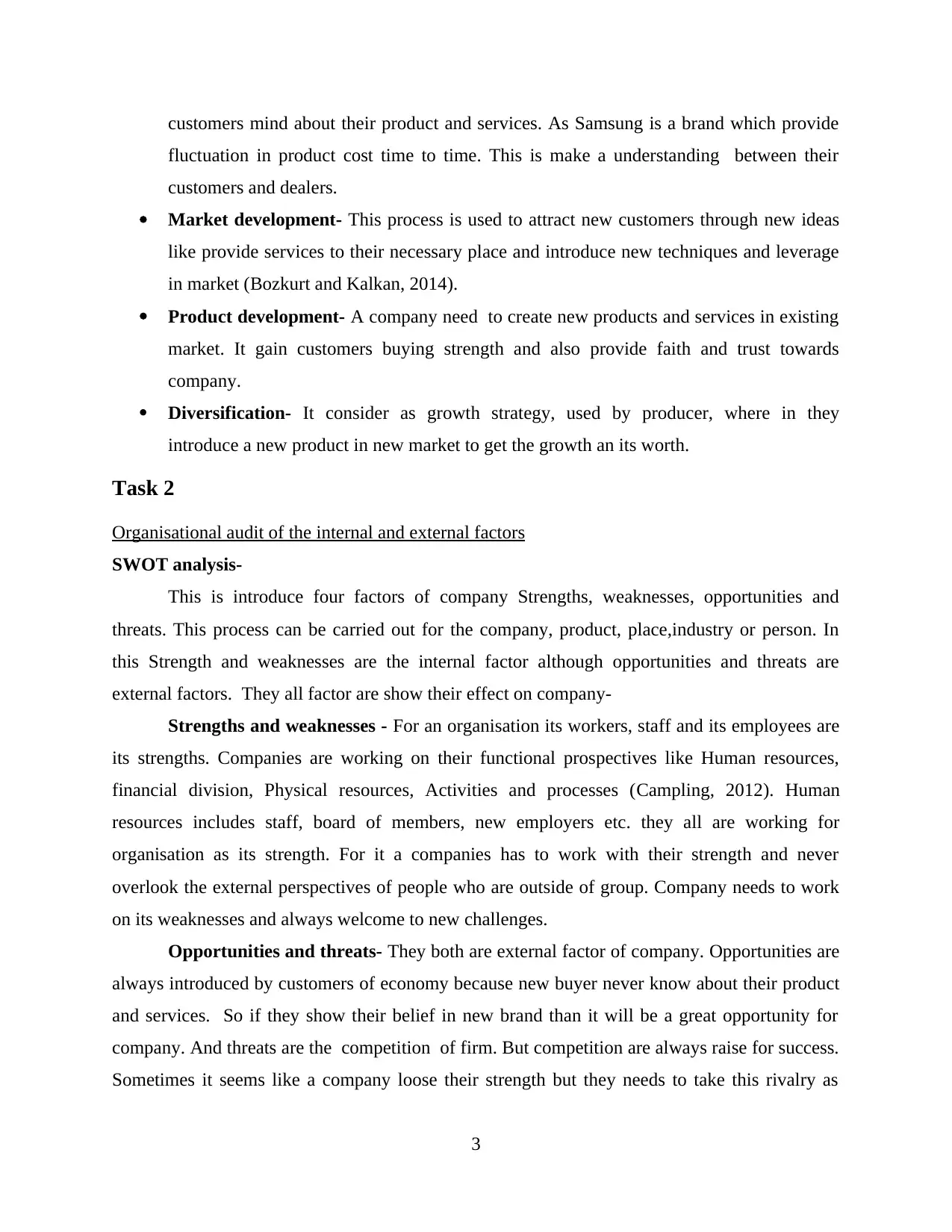
customers mind about their product and services. As Samsung is a brand which provide
fluctuation in product cost time to time. This is make a understanding between their
customers and dealers.
Market development- This process is used to attract new customers through new ideas
like provide services to their necessary place and introduce new techniques and leverage
in market (Bozkurt and Kalkan, 2014).
Product development- A company need to create new products and services in existing
market. It gain customers buying strength and also provide faith and trust towards
company.
Diversification- It consider as growth strategy, used by producer, where in they
introduce a new product in new market to get the growth an its worth.
Task 2
Organisational audit of the internal and external factors
SWOT analysis-
This is introduce four factors of company Strengths, weaknesses, opportunities and
threats. This process can be carried out for the company, product, place,industry or person. In
this Strength and weaknesses are the internal factor although opportunities and threats are
external factors. They all factor are show their effect on company-
Strengths and weaknesses - For an organisation its workers, staff and its employees are
its strengths. Companies are working on their functional prospectives like Human resources,
financial division, Physical resources, Activities and processes (Campling, 2012). Human
resources includes staff, board of members, new employers etc. they all are working for
organisation as its strength. For it a companies has to work with their strength and never
overlook the external perspectives of people who are outside of group. Company needs to work
on its weaknesses and always welcome to new challenges.
Opportunities and threats- They both are external factor of company. Opportunities are
always introduced by customers of economy because new buyer never know about their product
and services. So if they show their belief in new brand than it will be a great opportunity for
company. And threats are the competition of firm. But competition are always raise for success.
Sometimes it seems like a company loose their strength but they needs to take this rivalry as
3
fluctuation in product cost time to time. This is make a understanding between their
customers and dealers.
Market development- This process is used to attract new customers through new ideas
like provide services to their necessary place and introduce new techniques and leverage
in market (Bozkurt and Kalkan, 2014).
Product development- A company need to create new products and services in existing
market. It gain customers buying strength and also provide faith and trust towards
company.
Diversification- It consider as growth strategy, used by producer, where in they
introduce a new product in new market to get the growth an its worth.
Task 2
Organisational audit of the internal and external factors
SWOT analysis-
This is introduce four factors of company Strengths, weaknesses, opportunities and
threats. This process can be carried out for the company, product, place,industry or person. In
this Strength and weaknesses are the internal factor although opportunities and threats are
external factors. They all factor are show their effect on company-
Strengths and weaknesses - For an organisation its workers, staff and its employees are
its strengths. Companies are working on their functional prospectives like Human resources,
financial division, Physical resources, Activities and processes (Campling, 2012). Human
resources includes staff, board of members, new employers etc. they all are working for
organisation as its strength. For it a companies has to work with their strength and never
overlook the external perspectives of people who are outside of group. Company needs to work
on its weaknesses and always welcome to new challenges.
Opportunities and threats- They both are external factor of company. Opportunities are
always introduced by customers of economy because new buyer never know about their product
and services. So if they show their belief in new brand than it will be a great opportunity for
company. And threats are the competition of firm. But competition are always raise for success.
Sometimes it seems like a company loose their strength but they needs to take this rivalry as
3
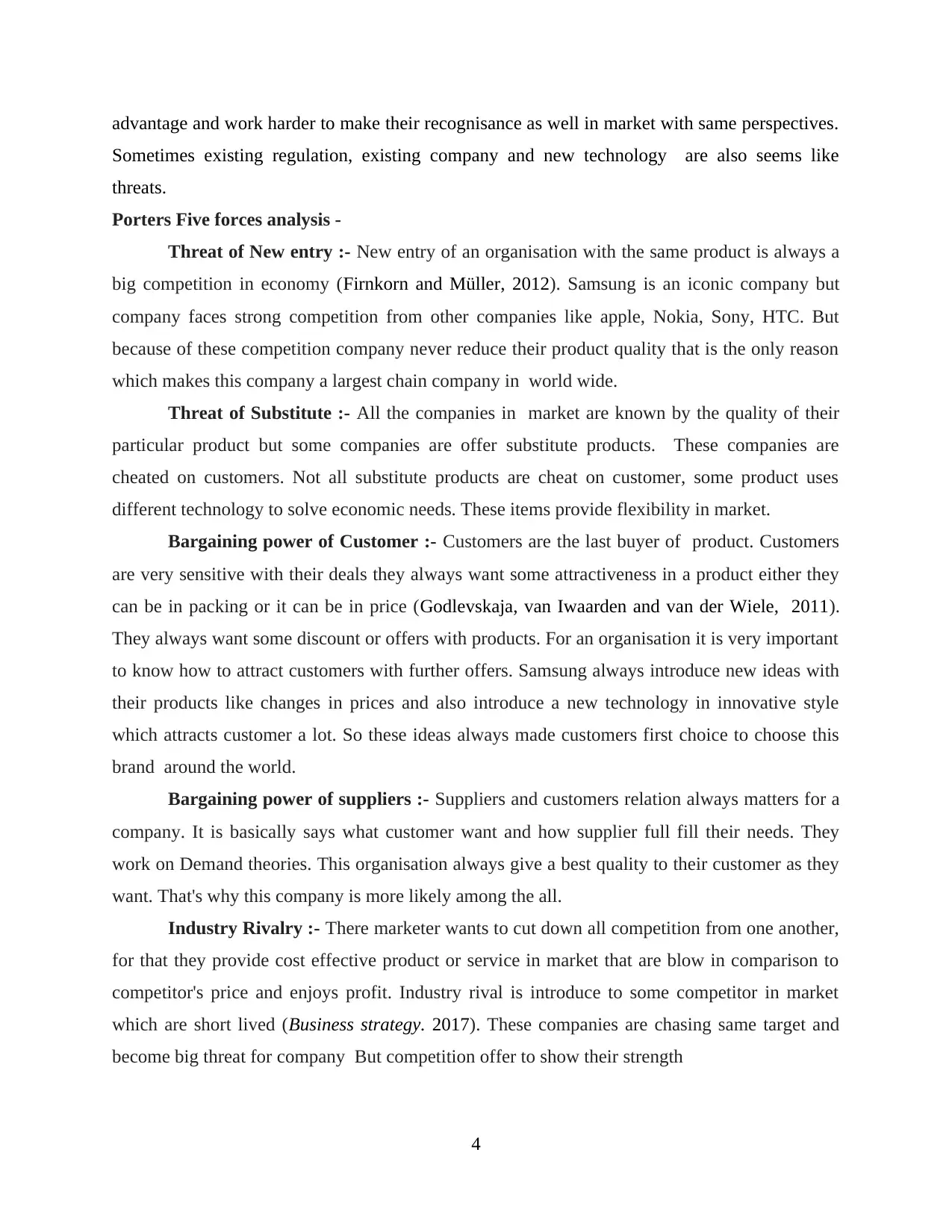
advantage and work harder to make their recognisance as well in market with same perspectives.
Sometimes existing regulation, existing company and new technology are also seems like
threats.
Porters Five forces analysis -
Threat of New entry :- New entry of an organisation with the same product is always a
big competition in economy (Firnkorn and Müller, 2012). Samsung is an iconic company but
company faces strong competition from other companies like apple, Nokia, Sony, HTC. But
because of these competition company never reduce their product quality that is the only reason
which makes this company a largest chain company in world wide.
Threat of Substitute :- All the companies in market are known by the quality of their
particular product but some companies are offer substitute products. These companies are
cheated on customers. Not all substitute products are cheat on customer, some product uses
different technology to solve economic needs. These items provide flexibility in market.
Bargaining power of Customer :- Customers are the last buyer of product. Customers
are very sensitive with their deals they always want some attractiveness in a product either they
can be in packing or it can be in price (Godlevskaja, van Iwaarden and van der Wiele, 2011).
They always want some discount or offers with products. For an organisation it is very important
to know how to attract customers with further offers. Samsung always introduce new ideas with
their products like changes in prices and also introduce a new technology in innovative style
which attracts customer a lot. So these ideas always made customers first choice to choose this
brand around the world.
Bargaining power of suppliers :- Suppliers and customers relation always matters for a
company. It is basically says what customer want and how supplier full fill their needs. They
work on Demand theories. This organisation always give a best quality to their customer as they
want. That's why this company is more likely among the all.
Industry Rivalry :- There marketer wants to cut down all competition from one another,
for that they provide cost effective product or service in market that are blow in comparison to
competitor's price and enjoys profit. Industry rival is introduce to some competitor in market
which are short lived (Business strategy. 2017). These companies are chasing same target and
become big threat for company But competition offer to show their strength
4
Sometimes existing regulation, existing company and new technology are also seems like
threats.
Porters Five forces analysis -
Threat of New entry :- New entry of an organisation with the same product is always a
big competition in economy (Firnkorn and Müller, 2012). Samsung is an iconic company but
company faces strong competition from other companies like apple, Nokia, Sony, HTC. But
because of these competition company never reduce their product quality that is the only reason
which makes this company a largest chain company in world wide.
Threat of Substitute :- All the companies in market are known by the quality of their
particular product but some companies are offer substitute products. These companies are
cheated on customers. Not all substitute products are cheat on customer, some product uses
different technology to solve economic needs. These items provide flexibility in market.
Bargaining power of Customer :- Customers are the last buyer of product. Customers
are very sensitive with their deals they always want some attractiveness in a product either they
can be in packing or it can be in price (Godlevskaja, van Iwaarden and van der Wiele, 2011).
They always want some discount or offers with products. For an organisation it is very important
to know how to attract customers with further offers. Samsung always introduce new ideas with
their products like changes in prices and also introduce a new technology in innovative style
which attracts customer a lot. So these ideas always made customers first choice to choose this
brand around the world.
Bargaining power of suppliers :- Suppliers and customers relation always matters for a
company. It is basically says what customer want and how supplier full fill their needs. They
work on Demand theories. This organisation always give a best quality to their customer as they
want. That's why this company is more likely among the all.
Industry Rivalry :- There marketer wants to cut down all competition from one another,
for that they provide cost effective product or service in market that are blow in comparison to
competitor's price and enjoys profit. Industry rival is introduce to some competitor in market
which are short lived (Business strategy. 2017). These companies are chasing same target and
become big threat for company But competition offer to show their strength
4
⊘ This is a preview!⊘
Do you want full access?
Subscribe today to unlock all pages.

Trusted by 1+ million students worldwide
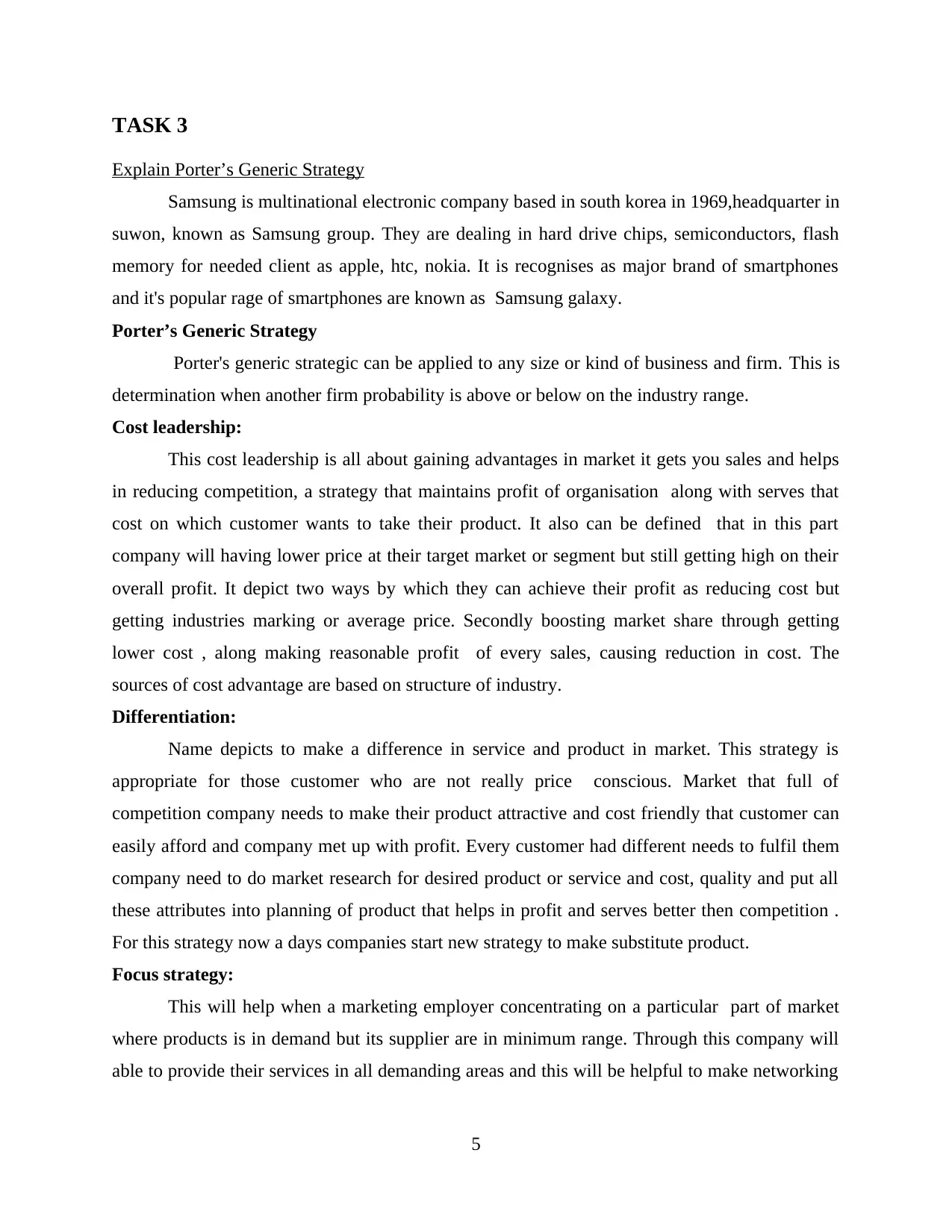
TASK 3
Explain Porter’s Generic Strategy
Samsung is multinational electronic company based in south korea in 1969,headquarter in
suwon, known as Samsung group. They are dealing in hard drive chips, semiconductors, flash
memory for needed client as apple, htc, nokia. It is recognises as major brand of smartphones
and it's popular rage of smartphones are known as Samsung galaxy.
Porter’s Generic Strategy
Porter's generic strategic can be applied to any size or kind of business and firm. This is
determination when another firm probability is above or below on the industry range.
Cost leadership:
This cost leadership is all about gaining advantages in market it gets you sales and helps
in reducing competition, a strategy that maintains profit of organisation along with serves that
cost on which customer wants to take their product. It also can be defined that in this part
company will having lower price at their target market or segment but still getting high on their
overall profit. It depict two ways by which they can achieve their profit as reducing cost but
getting industries marking or average price. Secondly boosting market share through getting
lower cost , along making reasonable profit of every sales, causing reduction in cost. The
sources of cost advantage are based on structure of industry.
Differentiation:
Name depicts to make a difference in service and product in market. This strategy is
appropriate for those customer who are not really price conscious. Market that full of
competition company needs to make their product attractive and cost friendly that customer can
easily afford and company met up with profit. Every customer had different needs to fulfil them
company need to do market research for desired product or service and cost, quality and put all
these attributes into planning of product that helps in profit and serves better then competition .
For this strategy now a days companies start new strategy to make substitute product.
Focus strategy:
This will help when a marketing employer concentrating on a particular part of market
where products is in demand but its supplier are in minimum range. Through this company will
able to provide their services in all demanding areas and this will be helpful to make networking
5
Explain Porter’s Generic Strategy
Samsung is multinational electronic company based in south korea in 1969,headquarter in
suwon, known as Samsung group. They are dealing in hard drive chips, semiconductors, flash
memory for needed client as apple, htc, nokia. It is recognises as major brand of smartphones
and it's popular rage of smartphones are known as Samsung galaxy.
Porter’s Generic Strategy
Porter's generic strategic can be applied to any size or kind of business and firm. This is
determination when another firm probability is above or below on the industry range.
Cost leadership:
This cost leadership is all about gaining advantages in market it gets you sales and helps
in reducing competition, a strategy that maintains profit of organisation along with serves that
cost on which customer wants to take their product. It also can be defined that in this part
company will having lower price at their target market or segment but still getting high on their
overall profit. It depict two ways by which they can achieve their profit as reducing cost but
getting industries marking or average price. Secondly boosting market share through getting
lower cost , along making reasonable profit of every sales, causing reduction in cost. The
sources of cost advantage are based on structure of industry.
Differentiation:
Name depicts to make a difference in service and product in market. This strategy is
appropriate for those customer who are not really price conscious. Market that full of
competition company needs to make their product attractive and cost friendly that customer can
easily afford and company met up with profit. Every customer had different needs to fulfil them
company need to do market research for desired product or service and cost, quality and put all
these attributes into planning of product that helps in profit and serves better then competition .
For this strategy now a days companies start new strategy to make substitute product.
Focus strategy:
This will help when a marketing employer concentrating on a particular part of market
where products is in demand but its supplier are in minimum range. Through this company will
able to provide their services in all demanding areas and this will be helpful to make networking
5
Paraphrase This Document
Need a fresh take? Get an instant paraphrase of this document with our AI Paraphraser
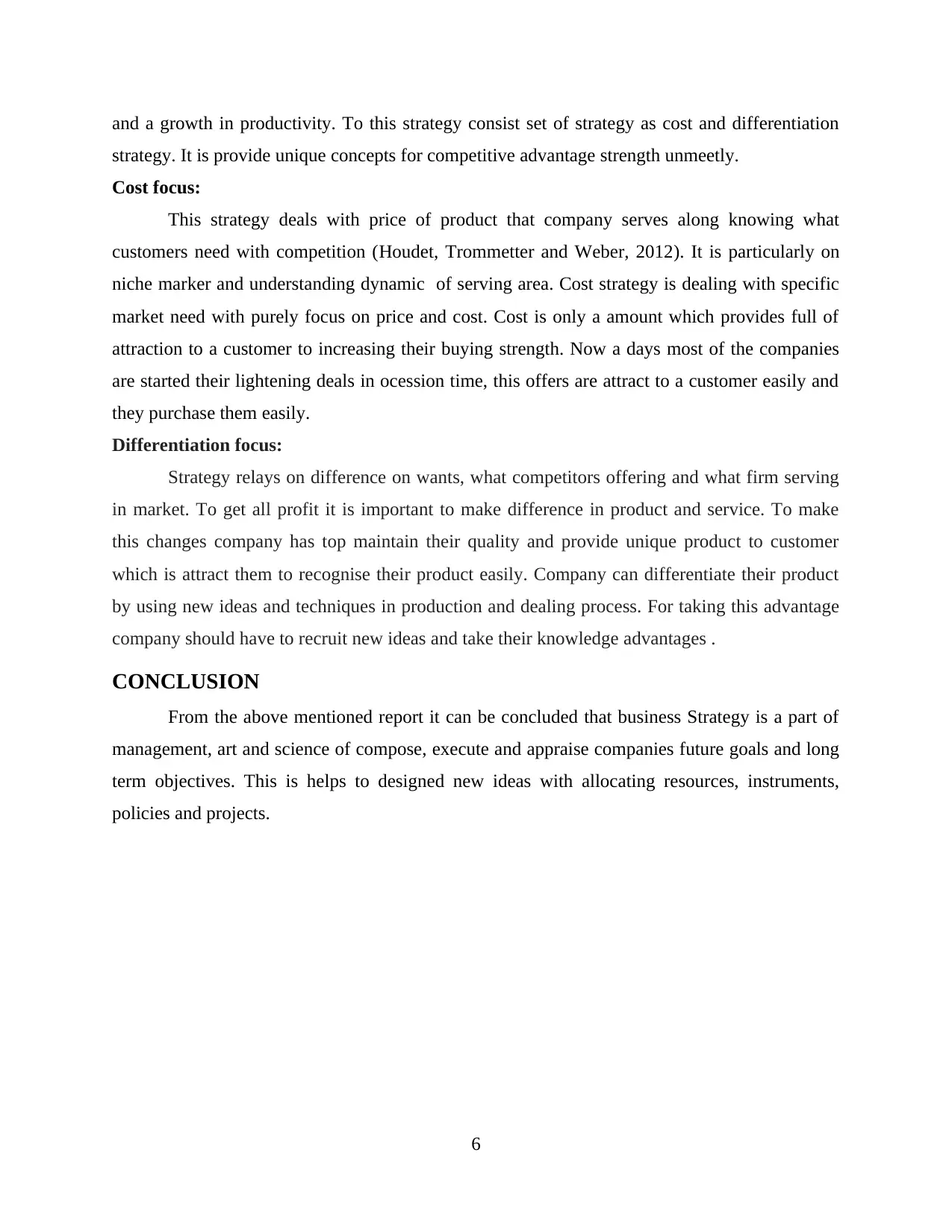
and a growth in productivity. To this strategy consist set of strategy as cost and differentiation
strategy. It is provide unique concepts for competitive advantage strength unmeetly.
Cost focus:
This strategy deals with price of product that company serves along knowing what
customers need with competition (Houdet, Trommetter and Weber, 2012). It is particularly on
niche marker and understanding dynamic of serving area. Cost strategy is dealing with specific
market need with purely focus on price and cost. Cost is only a amount which provides full of
attraction to a customer to increasing their buying strength. Now a days most of the companies
are started their lightening deals in ocession time, this offers are attract to a customer easily and
they purchase them easily.
Differentiation focus:
Strategy relays on difference on wants, what competitors offering and what firm serving
in market. To get all profit it is important to make difference in product and service. To make
this changes company has top maintain their quality and provide unique product to customer
which is attract them to recognise their product easily. Company can differentiate their product
by using new ideas and techniques in production and dealing process. For taking this advantage
company should have to recruit new ideas and take their knowledge advantages .
CONCLUSION
From the above mentioned report it can be concluded that business Strategy is a part of
management, art and science of compose, execute and appraise companies future goals and long
term objectives. This is helps to designed new ideas with allocating resources, instruments,
policies and projects.
6
strategy. It is provide unique concepts for competitive advantage strength unmeetly.
Cost focus:
This strategy deals with price of product that company serves along knowing what
customers need with competition (Houdet, Trommetter and Weber, 2012). It is particularly on
niche marker and understanding dynamic of serving area. Cost strategy is dealing with specific
market need with purely focus on price and cost. Cost is only a amount which provides full of
attraction to a customer to increasing their buying strength. Now a days most of the companies
are started their lightening deals in ocession time, this offers are attract to a customer easily and
they purchase them easily.
Differentiation focus:
Strategy relays on difference on wants, what competitors offering and what firm serving
in market. To get all profit it is important to make difference in product and service. To make
this changes company has top maintain their quality and provide unique product to customer
which is attract them to recognise their product easily. Company can differentiate their product
by using new ideas and techniques in production and dealing process. For taking this advantage
company should have to recruit new ideas and take their knowledge advantages .
CONCLUSION
From the above mentioned report it can be concluded that business Strategy is a part of
management, art and science of compose, execute and appraise companies future goals and long
term objectives. This is helps to designed new ideas with allocating resources, instruments,
policies and projects.
6
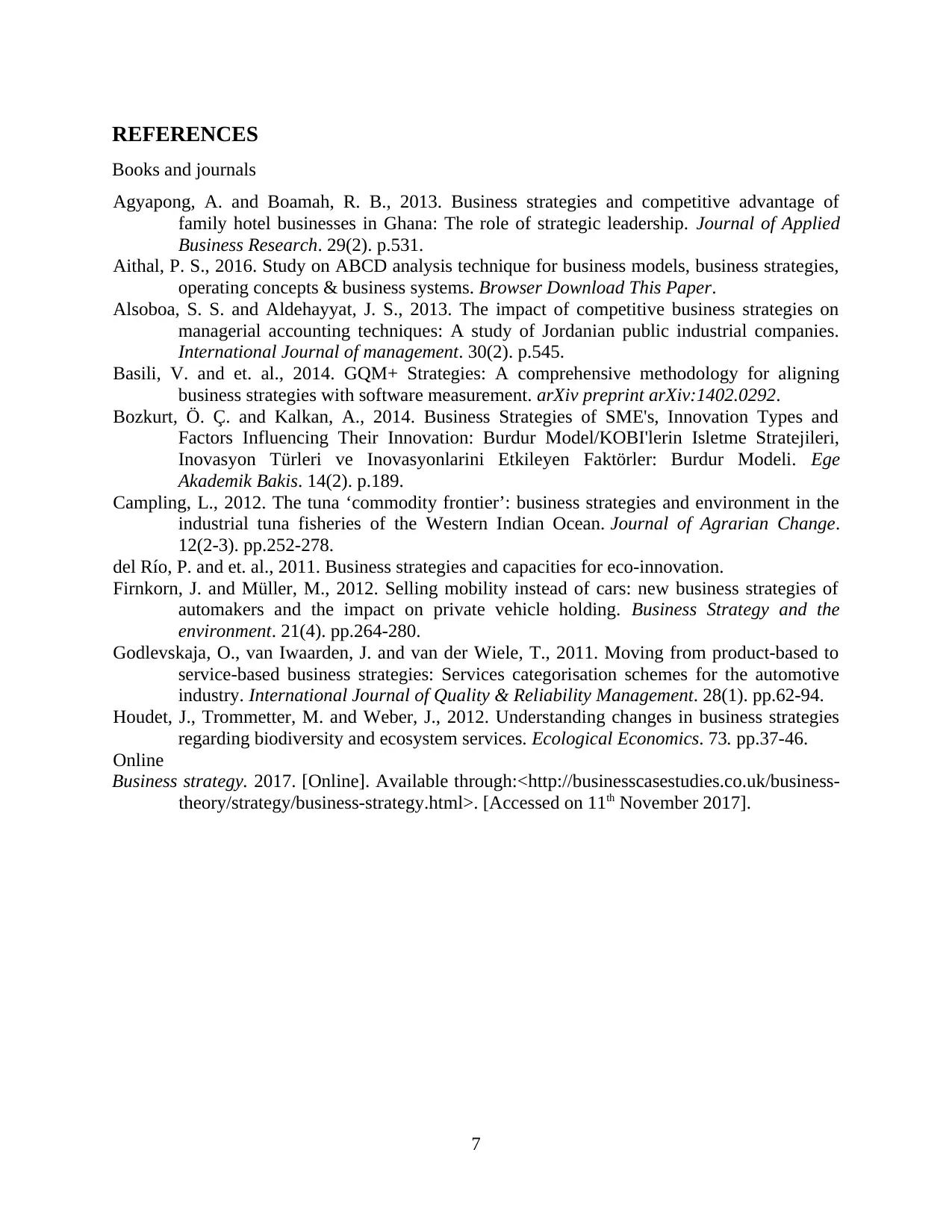
REFERENCES
Books and journals
Agyapong, A. and Boamah, R. B., 2013. Business strategies and competitive advantage of
family hotel businesses in Ghana: The role of strategic leadership. Journal of Applied
Business Research. 29(2). p.531.
Aithal, P. S., 2016. Study on ABCD analysis technique for business models, business strategies,
operating concepts & business systems. Browser Download This Paper.
Alsoboa, S. S. and Aldehayyat, J. S., 2013. The impact of competitive business strategies on
managerial accounting techniques: A study of Jordanian public industrial companies.
International Journal of management. 30(2). p.545.
Basili, V. and et. al., 2014. GQM+ Strategies: A comprehensive methodology for aligning
business strategies with software measurement. arXiv preprint arXiv:1402.0292.
Bozkurt, Ö. Ç. and Kalkan, A., 2014. Business Strategies of SME's, Innovation Types and
Factors Influencing Their Innovation: Burdur Model/KOBI'lerin Isletme Stratejileri,
Inovasyon Türleri ve Inovasyonlarini Etkileyen Faktörler: Burdur Modeli. Ege
Akademik Bakis. 14(2). p.189.
Campling, L., 2012. The tuna ‘commodity frontier’: business strategies and environment in the
industrial tuna fisheries of the Western Indian Ocean. Journal of Agrarian Change.
12(2‐3). pp.252-278.
del Río, P. and et. al., 2011. Business strategies and capacities for eco-innovation.
Firnkorn, J. and Müller, M., 2012. Selling mobility instead of cars: new business strategies of
automakers and the impact on private vehicle holding. Business Strategy and the
environment. 21(4). pp.264-280.
Godlevskaja, O., van Iwaarden, J. and van der Wiele, T., 2011. Moving from product-based to
service-based business strategies: Services categorisation schemes for the automotive
industry. International Journal of Quality & Reliability Management. 28(1). pp.62-94.
Houdet, J., Trommetter, M. and Weber, J., 2012. Understanding changes in business strategies
regarding biodiversity and ecosystem services. Ecological Economics. 73. pp.37-46.
Online
Business strategy. 2017. [Online]. Available through:<http://businesscasestudies.co.uk/business-
theory/strategy/business-strategy.html>. [Accessed on 11th November 2017].
7
Books and journals
Agyapong, A. and Boamah, R. B., 2013. Business strategies and competitive advantage of
family hotel businesses in Ghana: The role of strategic leadership. Journal of Applied
Business Research. 29(2). p.531.
Aithal, P. S., 2016. Study on ABCD analysis technique for business models, business strategies,
operating concepts & business systems. Browser Download This Paper.
Alsoboa, S. S. and Aldehayyat, J. S., 2013. The impact of competitive business strategies on
managerial accounting techniques: A study of Jordanian public industrial companies.
International Journal of management. 30(2). p.545.
Basili, V. and et. al., 2014. GQM+ Strategies: A comprehensive methodology for aligning
business strategies with software measurement. arXiv preprint arXiv:1402.0292.
Bozkurt, Ö. Ç. and Kalkan, A., 2014. Business Strategies of SME's, Innovation Types and
Factors Influencing Their Innovation: Burdur Model/KOBI'lerin Isletme Stratejileri,
Inovasyon Türleri ve Inovasyonlarini Etkileyen Faktörler: Burdur Modeli. Ege
Akademik Bakis. 14(2). p.189.
Campling, L., 2012. The tuna ‘commodity frontier’: business strategies and environment in the
industrial tuna fisheries of the Western Indian Ocean. Journal of Agrarian Change.
12(2‐3). pp.252-278.
del Río, P. and et. al., 2011. Business strategies and capacities for eco-innovation.
Firnkorn, J. and Müller, M., 2012. Selling mobility instead of cars: new business strategies of
automakers and the impact on private vehicle holding. Business Strategy and the
environment. 21(4). pp.264-280.
Godlevskaja, O., van Iwaarden, J. and van der Wiele, T., 2011. Moving from product-based to
service-based business strategies: Services categorisation schemes for the automotive
industry. International Journal of Quality & Reliability Management. 28(1). pp.62-94.
Houdet, J., Trommetter, M. and Weber, J., 2012. Understanding changes in business strategies
regarding biodiversity and ecosystem services. Ecological Economics. 73. pp.37-46.
Online
Business strategy. 2017. [Online]. Available through:<http://businesscasestudies.co.uk/business-
theory/strategy/business-strategy.html>. [Accessed on 11th November 2017].
7
⊘ This is a preview!⊘
Do you want full access?
Subscribe today to unlock all pages.

Trusted by 1+ million students worldwide
1 out of 9
Related Documents
Your All-in-One AI-Powered Toolkit for Academic Success.
+13062052269
info@desklib.com
Available 24*7 on WhatsApp / Email
![[object Object]](/_next/static/media/star-bottom.7253800d.svg)
Unlock your academic potential
Copyright © 2020–2025 A2Z Services. All Rights Reserved. Developed and managed by ZUCOL.





